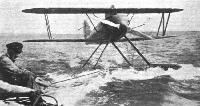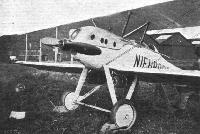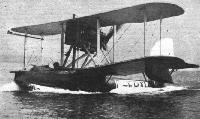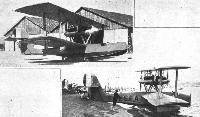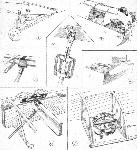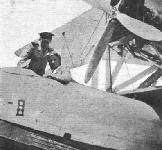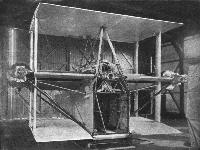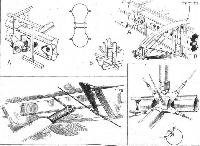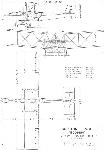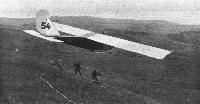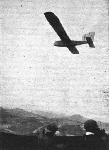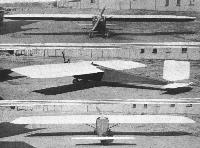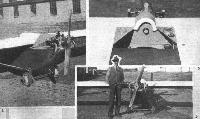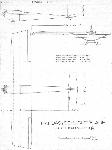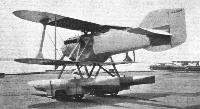Фотографии
-
SIR SAMUEL HOARE AT GOTHENBURG: This photograph, showing the British Air Minister being received on his arrival, was taken just after the Daimler Airway D.H.34, on which he made the trip, had landed at Torslanda aerodrome.
Самолёты на фотографии: De Havilland D.H.32 / D.H.34 - Великобритания - 1921
-
THE D.H.50 AT GOTHENBURG: On the left, Mr. Alan J. Cobham on arrival, with his two passengers, Admiral Mark Kerr (centre) and Mr. C. C. Walker, director of the De Havilland Company. On the right, Cobham with some Swedish friends. On Cobham's right is Dr. Malmer, who was responsible for the drawing up of the rules governing the competitions.
Самолёты на фотографии: De Havilland D.H.50 - Великобритания - 1923
-
A D.H.50 AT GOTHENBURG: Mr. Cobham getting out of his cockpit immediately after winning the competition
Самолёты на фотографии: De Havilland D.H.50 - Великобритания - 1923
-
Towing her out for a test: The Navy-Curtiss, photographed off Cowes. Note the clean design.
Самолёты на фотографии: Curtiss CR / R-6 - США - 1921
-
Регистрационный номер: F-ESFD THE SCHNEIDER CUP RACE: On the left, one of the C.A.M.S. racers is seen being transported up to S. E. Saunders' works, and on the right the same machine being rigged by a few professionals assisted by enthusiastic amateurs.
Самолёты на фотографии: CAMS CAMS 36 / CAMS 38 - Франция - 1922
-
A record breaker: Sadi Lecointe's Nieuport-Delage, 300 h.p. Hispano-Suiza engine, on which he has recently made several attacks on the world's altitude record. His best height so far has been 10,700 metres indicated, but this has not yet been homologated. Note the Lamblin radiators
Самолёты на фотографии: Nieuport Nieuport-29 - Франция - 1918
-
Rear and front views of the Cierva "Autogiro."
Самолёты на фотографии: Cierva C.4 / C.5 - Испания - 1923
-
Diagram showing the forces in the lifting vanes.
Самолёты на фотографии: Cierva C.4 / C.5 - Испания - 1923
-
The Albatros "L.59/60" is produced in two slightly differing types. The "L.59" is a single-seater with five-cylinder Siemens radial engine, while the "L.60" is a two-seater and is fitted with 7-cylinder Siemens radial. The type exhibited was the "L.60."
Самолёты на фотографии: Albatros L.59 / L.60 - Германия - 1923
-
Регистрационный номер: G-EBAH Out for a test: The Supermarine "Sea Lion," Mark II, Napier "Lion" engine, one of the Schneider Cup defenders, taxiing down Southampton Water preparatory to making a test flight piloted by Capt. Biard, winner of the Schneider Cup Race at Naples last year.
Самолёты на фотографии: Supermarine Sea Lion / Sea King - Великобритания - 1919
-
THE BLACKBURN SCHNEIDER CUP DEFENDER: A silhouette of the "Pellet" flying boat entered by the Blackburn Aeroplane and Motor Company, Ltd., which we reproduce from "The Olympian," the B.A.M.Co. house journal. The "Pellet" is fitted with a 450 h.p. Napier "Lion," mounted just above the top plane, the area of which is more than twice that of the bottom plane.
Самолёты на фотографии: Blackburn Pellet - Великобритания - 1923
-
Регистрационный номер: F-ESFA [2] THE C.A.M.S. TWIN-ENGINED FLYING BOAT: No. 3 is the type 33 bis, while the lower photograph shows the type 33. The engines are Hispano-Suizas. One of these machines won second place in the recent competition across the Mediterranean and back (St. Raphael-Corsica, Bizerta, Corsica-Berre).
Самолёты на фотографии: CAMS CAMS 33 - Франция - 1923
-
Регистрационный номер: F-ESFA [2] C.A.M.S.33 ON THE SEA: The larger photograph shows the type 33, while the inset shows the 33 Bis taking off.
Самолёты на фотографии: CAMS CAMS 33 - Франция - 1923
-
THE D.H.53: Front view, showing dihedral, wing bracing, struts, etc.
Самолёты на фотографии: De Havilland Humming Bird / D.H.53 - Великобритания - 1923
-
THE D.H.53: Three-quarter front view, and, on the left, a larger view of the engine and undercarriage.
Самолёты на фотографии: De Havilland Humming Bird / D.H.53 - Великобритания - 1923
-
THE D.H.53: Three-quarter rear view. This illustration gives a good idea of the shape of wings and tail, also indicates that the view from the pilot's cockpit is exceptionally good.
Самолёты на фотографии: De Havilland Humming Bird / D.H.53 - Великобритания - 1923
-
THE D.H.53: Side view.
Самолёты на фотографии: De Havilland Humming Bird / D.H.53 - Великобритания - 1923
-
THE D.H.53 LIGHT 'PLANE: Some constructional details. 1, General view of the undercarriage, of which some of the details are shown in 2; 3 shows the engine mounting, cowling, tank, etc.; and 4, the very simple engine plate. The fitting for one of the wing-tip cane skids is shown in 5. In 6 the construction of spars, ribs, and compression struts is indicated, as well as the substantial fitting for the wing struts. Details of the aileron sprocket mounting are shown in 7.
Самолёты на фотографии: De Havilland Humming Bird / D.H.53 - Великобритания - 1923
-
D.H.53 Light 'Plane 750 c.c. Douglas Engine
Самолёты на фотографии: De Havilland Humming Bird / D.H.53 - Великобритания - 1923
-
THE LOUIS SCHRECK F.B.A. FLYING BOAT, TYPE 17 H.E.2: General Arrangement Drawings, supplied by the constructors.
Самолёты на фотографии: FBA Type 16 / 17 - Франция - 1923
-
A Supermarine "Seagull" Amphibian, with Napier "Lion" Engine, at the Naval Base at Tokio: This photograph shows, standing up, Colonel the Master of Sempill, who was originally in charge of the British Aviation Mission to Japan, and, in the cockpit, Major Brackley, who took charge last year. Major Brackley is reported to have been on his way to England at the time of the terrible earthquake. All members of the British Aviation Mission are now reported to be safe.
Самолёты на фотографии: Supermarine Seal / Seagull - Великобритания - 1921
-
The most promising machine of this year's Rhon competition: Herr Martens' monoplane glider "Strolch," on which he has covered a distance of 13 kilometres (8 miles).
Самолёты на фотографии: Hannover H.1 Vampyr / H.2 Greif / Strolch - Германия - 1921
-
Регистрационный номер: J6910 THE BOULTON AND PAUL "BODMIN": Side view showing small auxiliary front wheels.
Самолёты на фотографии: Boulton Paul Bodmin / P.12 - Великобритания - 1922
-
THE BOULTON AND PAUL "BODMIN": View of the engine room and transmission.
Самолёты на фотографии: Boulton Paul Bodmin / P.12 - Великобритания - 1922
-
THE BOULTON AND PAUL "BODMIN": On the left, one of the gear casings, the tractor and pusher screws, and two main petrol tanks slung on a tubular braced member. On the right, a view of the tail skid, etc.
Самолёты на фотографии: Boulton Paul Bodmin / P.12 - Великобритания - 1922
-
THE BOULTON AND PAUL "BODMIN": Details of tail plane, spar and bracing strut attachment. The elevator has leading edge balance, and is carried on brackets from the rear spar. In the lower left-hand corner is shown the attachment of the tail plane bracing strut to the rear face of the spar. On the right, a typical fuselage fitting and section of longeron.
Самолёты на фотографии: Boulton Paul Bodmin / P.12 - Великобритания - 1922
-
Boulton Paul "Bodmin" 2-450 hp Napier "Lion" Engines
Самолёты на фотографии: Boulton Paul Bodmin / P.12 - Великобритания - 1922
-
Herr Standfuss starting on the Erfurt glider on which, later, he was killed while making a flight in the presence of General von Ludendorf. While flying In a very gusty wind the wing broke.
Самолёты на фотографии: Erfurt glider - Германия - 1923
-
THE ESSEN GLIDER IMMEDIATELY AFTER THE START: This machine was badly damaged in a crash, the pilot escaping with a sprained ankle.
Самолёты на фотографии: Essen glider - Германия - 1923
-
Herr Sthamer starting on the "Bremen'' for a flight to Gersfeld, where he delivered a mail-bag of letters written and "posted" on the Wasserkuppe. This was probably the first glider air mail.
Самолёты на фотографии: Weltensegler Bremen - Германия - 1923
-
The new Harth-Messerschmidt, piloted by Hackmack. The influence of "Vampyr" design is noticeable.
Самолёты на фотографии: Messerschmitt S14 - Германия - 1923
-
RAYNHAM'S HANDASYDE LIGHT 'PLANE: This machine is fitted with a Douglas flat twin air-cooled engine.
Самолёты на фотографии: Handasyde monoplane - Великобритания - 1923
-
THREE VIEWS OF RAYNHAM'S LIGHT 'PLANE, WITH 750 c.c. DOUGLAS ENGINE: This machine is a miniature monoplane of semi-cantilever type. The wing is braced on each side by one strut and one wire. The Douglas engine drives the tractor screw direct. The wing and tail are painted yellow (Raynham's racing colour) and the fuselage dark grey.
Самолёты на фотографии: Handasyde monoplane - Великобритания - 1923
-
THE HANDASYDE LIGHT 'PLANE: On the left, a view of the nose, showing the Douglas engine and the small-diameter direct-driven airscrew. The undercarriage is of very simple form, two short cantilever struts carrying the axle and rubber shock absorbers. On the right is shown, above, the pilot's cockpit, with the various instruments. Below, Raynham is seen standing by his machine. This photograph gives a good idea of the small overall height of the machine.
Самолёты на фотографии: Handasyde monoplane - Великобритания - 1923
-
RAYNHAM'S HANDASYDE LIGHT 'PLANE: Some constructional details. 1. Aileron hinge and crank. 2. Split pin locking device for elevator hinge pins, and elevator crank. 3. Attachment of wing to fuselage. 4. Details of the very simple undercarriage. 5. Mounting of the petrol and oil tank.
Самолёты на фотографии: Handasyde monoplane - Великобритания - 1923
-
Handasyde Light 'Plane 750 c.c. Douglas Engine
Самолёты на фотографии: Handasyde monoplane - Великобритания - 1923
-
The ill-fated Navy-Wright, photographed at Cowes shortly before the flight that ended in a crash. The propeller is stated to have burst and punctured the floats, with the consequence that the machine crashed when the pilot attempted to alight.
Самолёты на фотографии: Wright NW / F2W - США - 1922
-
Регистрационный номер: A-6544 [2] ANOTHER AMERICAN CHALLENGER: The Navy-Wright (N.W.-2) is to be piloted by Lieut. A. W. Gorton, U.S.N. The American machines have arrived, and are "stabled" at Saunders' of Cowes. The pilots will take every opportunity of getting in some flying practice, becoming familiar with the course, etc.
Самолёты на фотографии: Wright NW / F2W - США - 1922
-
Регистрационный номер: A-6544 [2] The American Navy-Wright Schneider Cup Challenger: A three-quarter rear view of the machine "dry." From this view a good idea of the strutting arrangement may be obtained. Note the wing-radiators and shape of the wings.
Самолёты на фотографии: Wright NW / F2W - США - 1922
-
THE VICKERS "VIGET" LIGHT 'PLANE: This photograph gives a good idea of the ease with which this machine can be wheeled along by one man. For transport over longer distances the wings are folded.
Самолёты на фотографии: Vickers Viget - Великобритания - 1923
-
THE VICKERS "VIGET": On the left, a view into the cockpit, and, on the right, the mounting of the Douglas engine. Note the chain reduction gear.
Самолёты на фотографии: Vickers Viget - Великобритания - 1923
-
THE VICKERS "VIGET" LIGHT 'PLANE: Some constructional details - 1. Analytical sketches of the fuselage fittings, which are made from Duralumin. 2. Sketch showing hinge on lower rear spar. 3. Locking pin with "umbrella" catch on top front spar. A small tube is used for slipping over the end of the pin, compressing the catch so that it will allow the pin to be withdrawn. 4. Diagrammatic perspective view of the tubular engine mounting. The upper tubes brace the top of the sprocket casing, while the engine is supported on the two front transverse tubes at the bottom. 5. Access to the pilot's cockpit is facilitated by a door in the coaming.
Самолёты на фотографии: Vickers Viget - Великобритания - 1923
-
Vickers "Viget" Light 'Plane 750cc Douglas Engine
Самолёты на фотографии: Vickers Viget - Великобритания - 1923
-
Регистрационный номер: F-ESEJ THE SCHNEIDER CUP RACE: One of the Latham machines photographed at Cowes just after its arrival. This machine was flown across by Duhamel. It is fitted with two 400 h.p. Lorraine-Dietrich engines.
Самолёты на фотографии: Latham L-1 / L-2 - Франция - 1923
Статьи
- Flight



